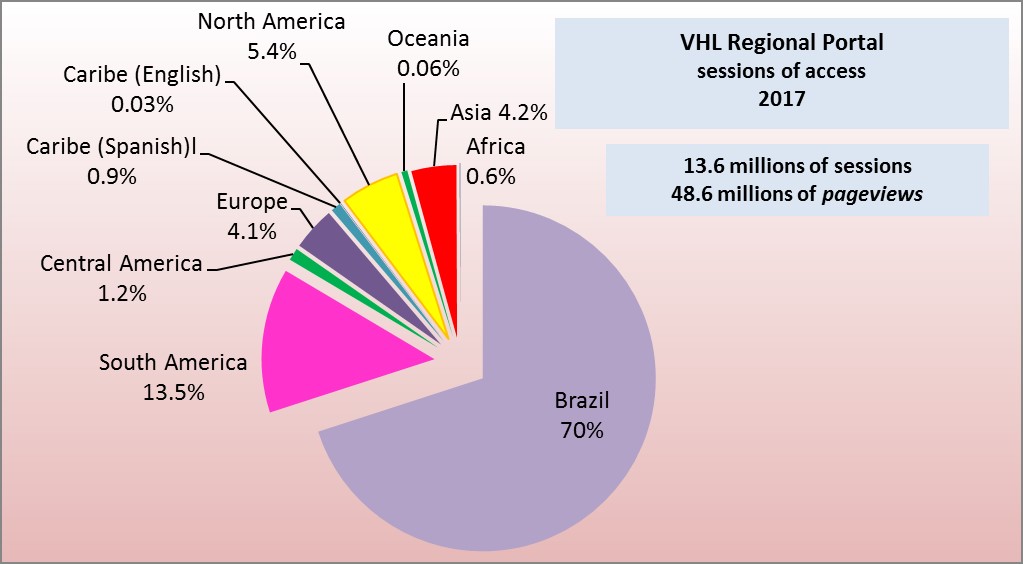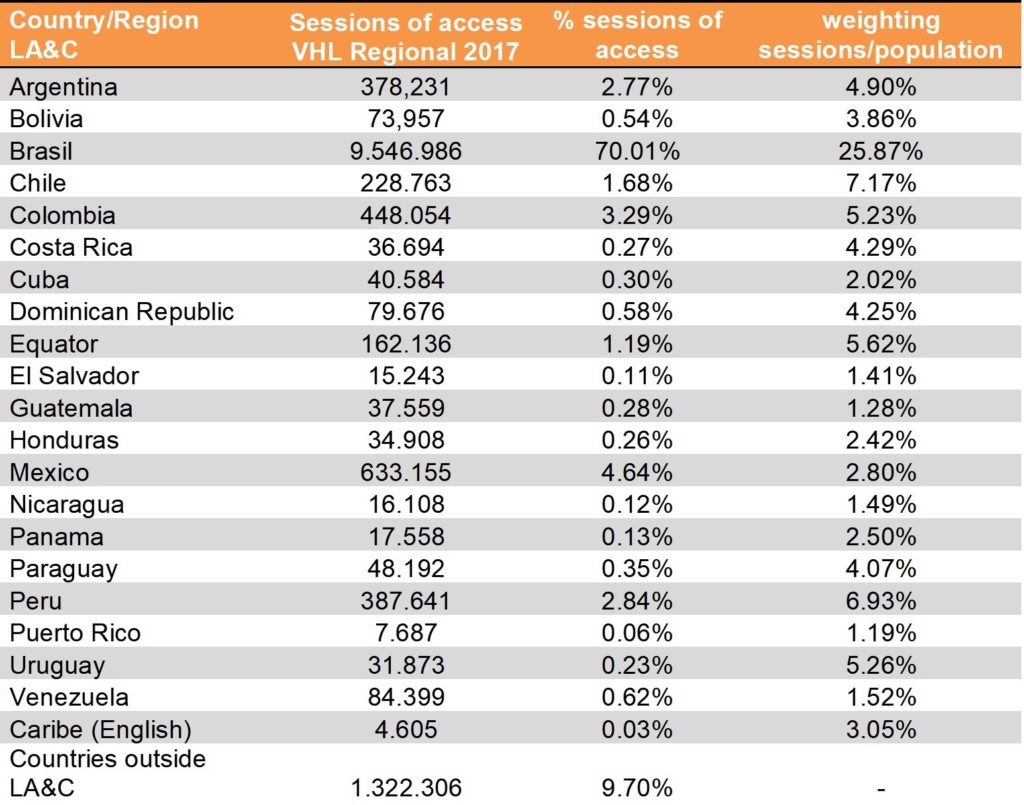The Information Services offered by BIREME through the Virtual Health Library (VHL) aims to promote the democratization of equitable access to scientific and technical information on health, and to meet the information needs of healthcare professionals in Latin America and Caribbean, through the efficient use of the VHL’s sources of information, development and updating of research resources, user training, and other services for users.
The VHL Regional Portal is the main access gateway to these services and gathers approximately 27 million bibliographic records of 35 databases, including Medline, LILACS, PAHO-IRIS Repository, national and theme-specific databases. It provides a search interface integrated to the Health Sciences Descriptors – DeCS vocabulary in 3 languages (Portuguese, English and Spanish), offers filters to refine search results per main subject, database, year of publication, language, and others. It also provides about 10 million links to the articles’ full texts and documents in the databases. Any user connected to the Internet can access the sources of information and contents of the VHL Regional Portal, by accessing the Portal directly or by searching through search engines such as Google or others.

Performance indicators of information access services are generated mainly from accesses records to the VHL Regional Portal and search services that allow users to find the scientific information and evidence they are looking for.
All access sessions, regardless of where or through where accesses comes from, are counted and generate indicators such as country and city from which the user accessed; type of device used for access (desktop, mobile or tablet); number of pageviews; in addition to number of sessions per day, time of the day, and average duration of access sessions.
A summary of the main 2017 indicators related to the search services of the VHL Regional Portal is presented below:
– 13.6 million access sessions by 8.5 million different users, 90% through a desktop and 10% through mobile or tablet.
– 48.6 million pageviews, which correspond to an average of 3.6 pageviews per session.
– Among all services, VHL’s integrated search recorded the highest number of pageviews per session – 8.71 pages/session and it kept users for the longest time on the service page – on average 10’26’’.

Who are the VHL Regional Portal users?
Since access to the VHL Regional Portal is totally free and users are not required to identify themselves before accessing the Portal and services available, access indicators do not record who users are, whether they are students, researchers or healthcare professionals, where they work or which education they have had. However, based on the analysis of access indicators, it is possible to know from where users are accessing (city, region, country), if they are connected to an academic, state or commercial internet access network, and if they are using a desktop computer or a mobile device (cellphone or tablet).
In 2017, the VHL Regional Portal was accessed by users from more than 200 countries in all regions of the world, and most accesses (90%) were from users in Latin America and the Caribbean (LA&C). Brazil is the country with the most accesses (70%), followed by Mexico (4.6%), Colombia (3.3%), Argentina, and Peru (both with 2.8%), and Spain (2.5%).

For a better analysis of indicators of access from LA&C and considering that the countries in the Region are different in many aspects, such as population size, development level, gross domestic product, etc., access indicators were weighed in relation to the population of LA&C countries[1] in 2016, and to reach a more balanced distribution of accesses.

Comparing accesses in absolute numbers with accesses weighed according to the populations of LA&C countries, the following facts stand out:
- Brazil is still the country that most accesses and uses the VHL, but with a smaller ratio (25%) as compared to the absolute number of accesses (70%);
- Other countries are better positioned in the access ranking, for example, Chile, Peru, Uruguay, Colombia, Ecuador, Argentina, and Paraguay;
- Mexico, which has the second largest population in the Region, leaves the second position (absolute numbers) and is no longer among the top countries with the most access; and
- English-speaking Caribbean countries have the smallest indicators of access to VHL services. Adding the accesses of Trinidad and Tobago, Jamaica, Barbados, Dominica, Suriname, Guyana, Haiti, Martinique, Belize, Guadalupe, Montserrat, Anguilla, and other English-speaking Caribbean islands, we get to the total of 4,600 accesses which accounts for about 0.03% of accesses in absolute number and 3% when weighed by the population of English-speaking Caribbean countries.
It is also interesting to know whether users access services from a desktop computer, mobile or tablet, as most of VHL service platforms are already responsive. The table below shows that the use of mobile devices (mobile and tablet) is still small (18%), but has been growing in relation to previous years and there is a growing trend.
Which conclusions can we draw from these indicators?
The information services that BIREME and its Network provide through the VHL have a large volume of accesses, on average 38,000 sessions per day to access the services presented herein, apart from many other portals that comprise the VHL Network and the access sessions to the DeCS Portal, which recorded more than 3 million access sessions in 2017. However, analyzing the geographic distribution of accesses, we have identified the need to expand VHL accesses originated from some LA&C countries and sub-regions, through actions to promote access and use of VHL services. Even in Brazil, when we analyze the geographic distribution of accesses, we identify a concentration of accesses in the South and Southeast regions, showing that it is necessary to promote more intensely access to the VHL in the North and Northeast regions.
Regarding access from mobile devices, this is a trend and indicates the importance of developing responsive platforms/portals.
All these actions contribute to meet BIREME’s mission to democratizing access to information, knowledge and evidence in health across the LA&C Region.
[1] Source: http://data.worldbank.org/country
